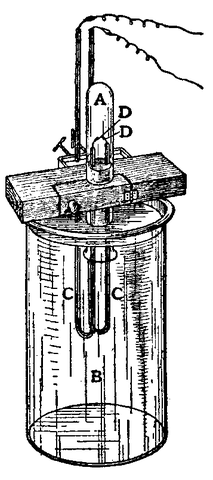
File:Isolation of Argon.png

Summary
| Description |
Cavendish's method for the isolation of Argon. The gases are contained in a test-tube (A) standing over a large quantity of weak alkali (B), and the current is conveyed in wires insulated by U-shaped glass tubes (CC) passing through the liquid and round the mouth of the test-tube. The inner platinum ends (DD) of the wire may be sealed into the glass insulating tubes, but reliance should not be placed upon these sealings. In order to secure tightness in spite of cracks, mercury is placed in the bends. With a battery of five Grove cells and a Ruhmkorff coil of medium size, a somewhat short spark, or arc, of about 5 mm is found to be more than favorable than a longer one. When the mixed gases are in the right proportion, the rate of absorption is about 30 cm3 per hour, about thirty times as fast as Cavendish could work with the electrical machine of his day. Where it is available, an alternating electric current is much superior to a battery and break, allowing the absorption in the apparatus to be raised to about 80 cm3/hour. |
|---|---|
| Source |
Encyclopædia Britannica Eleventh Edition, Vol. 2, Page 476 |
| Date |
1911 |
| Author |
Encyclopædia Britannica |
| Permission ( Reusing this file) |
Public domain
|
Licensing:
 |
This is a candidate to be copied to Wikimedia Commons. Freely licensed or public domain media are more accessible to other Wikimedia projects if placed on Commons. Any user may perform this move—please see Moving images to the Commons for more information. Please thoroughly review the copyright status of this file and ensure that it is actually eligible for transfer to Commons. If you are concerned that this file could have problems with its attribution information and/or copyright status, then remove this notice and DO NOT transfer it to Commons. By transferring this file to Commons, you acknowledge you have read this message and are willing to accept any and all consequences for inappropriate transfers. Repeat violators will be blocked from editing. If you have checked the file and it is OK to move to Commons add "|human=username" to the template so other users can see it has been checked and can help you copy the file to Commons. If the file has already been moved to Commons, then consider nominating the file for deletion or changing the template to {{Already moved to Commons}} If the file can't be moved to Commons because it doesn't fit Common's scope, then use {{Do not move to Commons|reason=Why it can't be moved to Commons}} If you think that a local copy of this file should be kept, then use {{Keep local}}. Consider using {{Keep local|reason=Why the English Wikipedia needs a local copy}} Copy to Commons: via CommonsHelper |
||
|
|||
File usage
I want to learn more...
Wikipedia for Schools is one of SOS Children's Villages' many educational projects. SOS Children is an international children's charity, providing a good home and loving family to thousands of children who have lost their parents. We also work with communities to help vulnerable families stay together and raise children in the best possible environment. Sponsoring a child is the coolest way to help.

